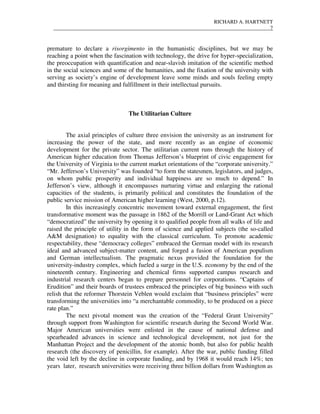The article discusses three cultures—rational, spiritual, and political/utilitarian—that have historically shaped American universities since the mid-nineteenth century. The author argues that the current dominance of the utilitarian culture threatens the spiritual culture, thus compromising the multiversity's effectiveness and balance. As this equilibrium becomes precarious, the viability of the university's mission and social role faces significant challenges.








![RICHARD A. HARTNETT
___________________________________________________________________________________9
funding expanded at an annual rate of about eight percent (approaching two billion
dollars in 1997), nearly eight times the ratio of investment two decades before.
Universities processed almost 5000 patent applications in 1998, up from only 250 per
year before Bayh-Dole.
This unprecedented engagement with the marketplace was concurrent in many
states with a steep downturn in the ratio of public support for its flagship universities.
Some state land-grant universities saw their apportionment decline from around 40% of
annual revenue to less that 20% in less than a decade. To offset the reduction, they turned
to raising tuition and fees and encouraged the faculty, not just in the sciences and
technical fields, to follow the centrifugal forces of engagement with the market.
Universities became “co-capitalists” with businesses, with the market serving as a major
determining factor in its campus priorities, shaping institutional values and driving
campus priorities.
The saga of the utilitarian culture from the first Morrill Act to the Bayh-Dole Act
is a steady progression from making the boundary between the university and society
more permeable to erasing completely any distinction between the two realms; from
attempting to rejuvenate the curriculum by forcing the classical curriculum to compete
with the sciences and the social sciences in the new elective system to marginalizing the
humanities and neglecting their role in self-cultivation and moral development; from
awakening the university to its responsibilities to the state to making the university’s
focus a contractual extension of the state; from establishing a professional preparation
center for scientists and technicians for industrial development to creating a vocational
training enterprise; and from building a pluralistic “city of the intellect” with support for
the triad of the disciplines nurturing the soul and intellect, the specialized sciences, the
professions, and applied fields, and an engine for social change and economic
amelioration to constructing a market-model enterprise which seeks to meet
environmental opportunities and fill “niches.”
Concluding Remarks
In conclusion, the cultural contradictions among the three models, which were
formerly held in check, or coexisted in a state of dynamic equilibrium because no one of
them was capable of totally dominating the other the two, are no longer a productive
tension. The university’s capacity to maintain its multiversity or pluralistic mission,
which is rooted in the deeper tripartite self of the rational, affective, and volitional, is
jeopardized. When the university serves only as an instrument for external ends, it loses
its life-giving power, which is centered in the spiritual and rational core.
In the face of an impotent spiritual culture, the corporate culture overwhelms the
core principles of the university, reminiscent of an earlier transformation between 1890-
1930 when American society was transformed by commercialism. Again, consumerism
has become the predominant vision of the good life, “a culture of desire that confuse[s]
the good life with goods” (Leach, 2001, p. 116). The most alarming consequence of the](https://image.slidesharecdn.com/dr-harnett-article-1216396947869341-8/85/Dr-Harnett-Article-9-320.jpg)

